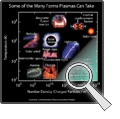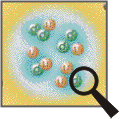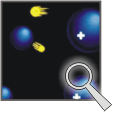|
 Plasmas
come in many varieties depending on their
temperature and density. There
are often so few plasma particles (ions and
electrons) in a volume of space (thus the
number density, particles per unit volume,
is low) that a spacecraft could fly right
through them
without
damage – even though the temperature
of the plasma is thousands of degrees. However,
really high energy charged particles can damage
spacecraft. The graphic above (temperature
vs. number density) shows
some
of the many
forms
a plasma
can take
(both natural and manmade). Plasmas
come in many varieties depending on their
temperature and density. There
are often so few plasma particles (ions and
electrons) in a volume of space (thus the
number density, particles per unit volume,
is low) that a spacecraft could fly right
through them
without
damage – even though the temperature
of the plasma is thousands of degrees. However,
really high energy charged particles can damage
spacecraft. The graphic above (temperature
vs. number density) shows
some
of the many
forms
a plasma
can take
(both natural and manmade).
Making
Plasma
| Think
of water – when it’s frozen,
it’s a solid. When it melts,
it’s a liquid. Heat it and it
turns into a vapor or gas. If you heat
it even more – to around 1,500°F – water
becomes a plasma. |
Plasma is made up of atoms
 Atoms
are so tiny that more than a million
can fit across the head of a pin. They
are composed of one or more negatively
charged electrons that orbit a positively
charged nucleus (made up of neutral
particles, called neutrons, and positively
charged particles, called protons).
Atoms are electrically neutral; they
have the same number of positive and
negative electrical charges. Atoms
are so tiny that more than a million
can fit across the head of a pin. They
are composed of one or more negatively
charged electrons that orbit a positively
charged nucleus (made up of neutral
particles, called neutrons, and positively
charged particles, called protons).
Atoms are electrically neutral; they
have the same number of positive and
negative electrical charges.
|
 When
gases are exposed to enough heat or other
radiation, their electrically neutral atoms
split into positively charged fragments
called ions and negatively charged free
electrons. Another term for plasma is "ionized
gas". Because plasma consists of electrically
charged particles, it acts very differently
from ordinary forms of gas. Neutral atoms
behave the way they do because of collisions.
Plasmas, on the other hand, are influenced
by electric and magnetic fields. Some plasmas
(Earth’s ionosphere, for example)
are also influenced by collisions but most
are not. When
gases are exposed to enough heat or other
radiation, their electrically neutral atoms
split into positively charged fragments
called ions and negatively charged free
electrons. Another term for plasma is "ionized
gas". Because plasma consists of electrically
charged particles, it acts very differently
from ordinary forms of gas. Neutral atoms
behave the way they do because of collisions.
Plasmas, on the other hand, are influenced
by electric and magnetic fields. Some plasmas
(Earth’s ionosphere, for example)
are also influenced by collisions but most
are not.
|